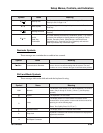
701344-003 4-3
Operating Procedures
Assigning a Coax Printer
Each display station in a system configuration can be assigned a Host printer for
generating copies of information displayed on the screen. These copies can be used to
maintain records of terminal/CPU transactions.
For 104-key and 122-key keyboards, press and hold the Alt key, then press the Ident key
to display the Assign Printer condition symbol (
– –
) on the operator status row.
For 102/103-key keyboards, press and hold the Shift key, then press the Ident key to
display the symbol.
Note: If
99
appears on the operator status row when the Ident key is pressed,
the
– –
will not display. Enter Setup mode and select Host printer
instead of Screen printer or Trimmed Print. This allows you to assign the coax
printer.
Consult your supervisor for an available coax printer’s ID number and enter the two-
digit number for the printer being assigned. The two-digit number replaces the
underscore positions on the operator status row. Once the printer’s ID number is
entered, the sequence ends automatically.
If an invalid ID number is entered for a Host printer, the “What?” symbol (X ?+) appears
on the operator status row. If this occurs, press the Reset key and try another number.
Data Entry Function
The data entry function consists of writing data messages in an acceptable form for
computer processing. As you enter messages through the keyboard, they are displayed
on the screen either as unformatted information or according to a program determined
format. Attributes of the formatted display screen fields control the amount and type
(alphanumeric or numeric) of entered data.
Figure 4-1 on Page 4-4 shows a typical formatted display screen. All fields on the
screen are preceded by a nondisplayed attribute character and are defined as
protected or unprotected (entry) fields. For protected fields, the application program
fills in the information following the attribute characters. Attempts to change
displayed information in a protected field cause a “Go Elsewhere” condition symbol
(
X
) to be displayed on the operator status row. The unprotected (or entry)
fields accept new or revised information from the operator. Some application
programs further designate an entry field by displaying the cursor in the unprotected
field’s first character position.


















